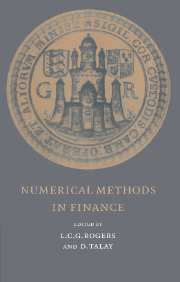Book contents
- Frontmatter
- Contents
- Contributors
- Introduction
- Convergence of Numerical Schemes for Degenerate Parabolic Equations Arising in Finance Theory
- Continuous-Time Monte Carlo Methods and Variance Reduction
- Recent Advances in Numerical Methods for Pricing Derivative Securities
- American Options: A Comparison of Numerical Methods
- Fast, Accurate and Inelegant Valuation of American Options
- Valuation of American Option in a Jump-diffusion Models
- Some Nonlinear Methods for Studying Far-from-the-money Contingent Claims
- Monte Carlo Methods for Stochastic Volatility Models
- Dynamic Optimization for a Mixed Portfolio with Transaction Costs
- Imperfect Markets and Backward Stochastic Differential Equations
- Reflected Backward SDEs and American Options
- Numerical Methods for Backward Stochastic Differential Equations
- Viscosity Solutions and Numerical Schemes for Investment/Consumption Models with Transaction Costs
- Does Volatility Jump or Just Diffuse? A Statistical Approach
- Martingale-Based Hedge Error Control
- The Use of Second-Order Stochastic Dominance To Bound European Call Prices: Theory and Results
Reflected Backward SDEs and American Options
Published online by Cambridge University Press: 05 June 2012
- Frontmatter
- Contents
- Contributors
- Introduction
- Convergence of Numerical Schemes for Degenerate Parabolic Equations Arising in Finance Theory
- Continuous-Time Monte Carlo Methods and Variance Reduction
- Recent Advances in Numerical Methods for Pricing Derivative Securities
- American Options: A Comparison of Numerical Methods
- Fast, Accurate and Inelegant Valuation of American Options
- Valuation of American Option in a Jump-diffusion Models
- Some Nonlinear Methods for Studying Far-from-the-money Contingent Claims
- Monte Carlo Methods for Stochastic Volatility Models
- Dynamic Optimization for a Mixed Portfolio with Transaction Costs
- Imperfect Markets and Backward Stochastic Differential Equations
- Reflected Backward SDEs and American Options
- Numerical Methods for Backward Stochastic Differential Equations
- Viscosity Solutions and Numerical Schemes for Investment/Consumption Models with Transaction Costs
- Does Volatility Jump or Just Diffuse? A Statistical Approach
- Martingale-Based Hedge Error Control
- The Use of Second-Order Stochastic Dominance To Bound European Call Prices: Theory and Results
Summary
Introduction
We have seen in El Karoui & Quenez (1997) that the pricing of European contingent claims, even in imperfect markets, can be formulated in terms of backward stochastic differential equations. However, the case of American options has not be considered. In this article, we will see that the price of an American option corresponds to the solution of a new type of backward equation called reflected BSDEs. The solution of such an equation is forced to stay above a given stochastic process, called the obstacle. An increasing process is introduced which pushes the solution upwards, so that it may remain above the obstacle. Recall that by definition the price of an American option is constrained to be greater than the payoff of the option (which corresponds to the obstacle). Furthermore, in a perfect market, it is well known (see Bensoussan (1984), Karatzas & Shreve (1995) and Karatzas (1988)) that such options cannot be perfectly hedged by a portfolio; in this case, the price process corresponds to the minimal ‘superhedging’ strategy for the option, that is a strategy with a so-called ‘tracking’ error which is an increasing process. We will see that this property can be generalized to imperfect markets.
In this article, we will refer often to the previous one by El Karoui & Quenez (1997) concerning the different results on BSDEs and also the notation. The problem is formulated in detail in Section 2.
- Type
- Chapter
- Information
- Numerical Methods in Finance , pp. 215 - 231Publisher: Cambridge University PressPrint publication year: 1997
- 66
- Cited by



